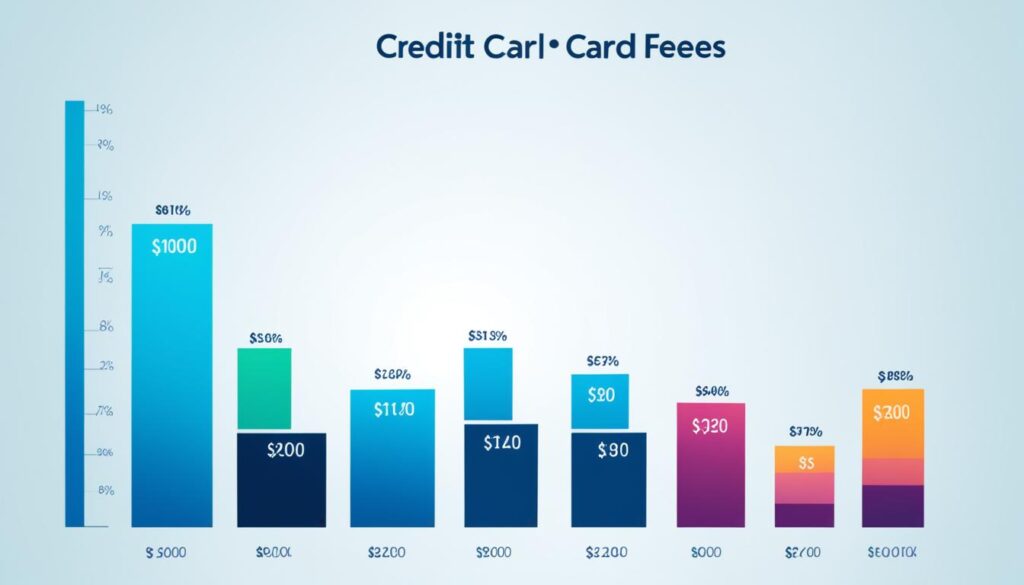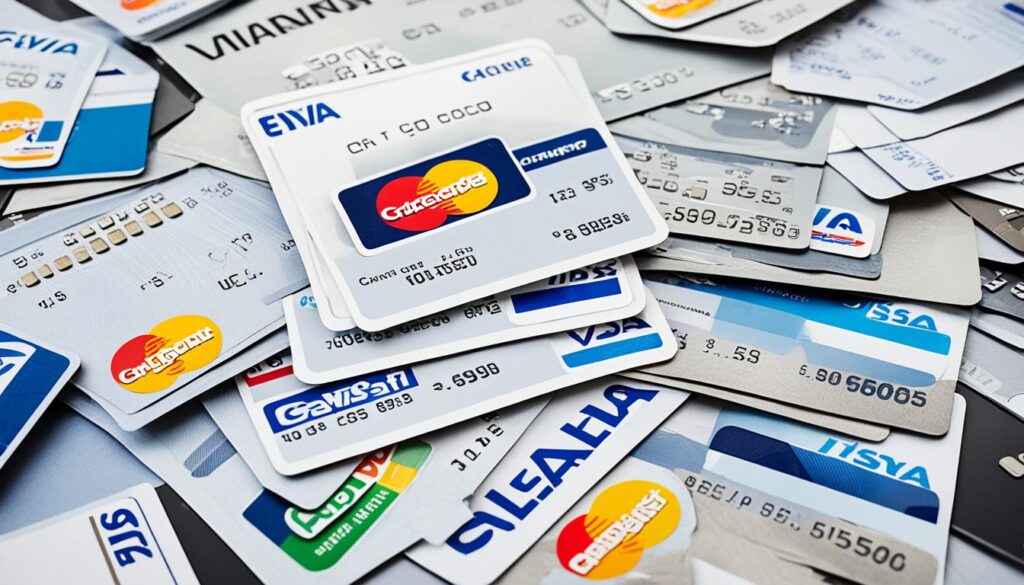Did you know that credit card processing fees can eat into the profits of small and medium-sized businesses, impacting their financial stability? It’s true! For SMBs in industries where transaction amounts can be substantial, it is crucial to understand and manage credit card processing fees in order to strike a balance between customer satisfaction and profitability.
In this article, we’ll explore three common options for handling credit card processing fees, weighing the pros and cons of each. From interchange fees and assessment fees to payment processing fees, we’ll break down the different costs involved in accepting credit card payments.
Key Takeaways:
- Understanding credit card processing fees is important for small and medium-sized businesses.
- There are various types of fees, including interchange fees and assessment fees.
- Payment processing fees cover the cost of transferring funds between banks.
- The average cost of credit card merchant fees ranges between 1.4% and 3.5%.
- Choosing the right pricing model can help minimize credit card merchant fees.
What Are Credit Card Merchant Fees?
Credit card merchant fees are the charges applied by credit card companies, through the customer’s issuing bank, for using a credit card to make a purchase. These fees vary depending on the credit card company and the specific merchant service provider that processes the card transactions. Typically, credit card merchant fees consist of a percentage of the total sale amount and a standard fee for each transaction.
There are different types of credit card processing fees that merchants should be aware of when considering payment options. These include:
- Interchange fees: These fees are charged by the credit card issuer and cover costs such as handling charges, fraud prevention, and potential bad debt. The amount a merchant pays in interchange fees is determined by various factors, including the transaction amount, the merchant’s industry category, the type of card used, and the method of processing.
- Assessment fees: Also known as credit card brand fees, assessment fees are paid to the card network (e.g., Visa or Mastercard) that facilitates the transactions. The assessment fee is usually calculated based on the merchant’s total monthly card sales.
- Payment processing fees: These fees encompass the costs associated with processing credit card payments. They cover the behind-the-scenes work performed by the payment processor, ensuring that funds are securely transferred between the customer’s bank account and the merchant’s bank account. Payment processing fees can include various components such as payment gateway fees, PCI compliance fees, chargeback fees, software-as-a-service (SaaS) fees, hardware fees, address verification service (AVS) fees, and monthly service fees.
Understanding credit card merchant fees is essential for merchants, as these fees can significantly impact the profitability of their businesses. By having a clear understanding of the different types of fees involved, merchants can make informed decisions about payment processing solutions that best suit their needs.

Interchange Fees and Assessment Fees
Interchange fees and assessment fees are important components of credit card merchant fees. Understanding these fees is essential for businesses that accept credit card payments. Let’s take a closer look at what interchange fees and assessment fees are and how they impact merchants.
Interchange Fees
Interchange fees are charges imposed by card issuers to cover various expenses, including handling costs, fraud prevention, and managing bad debt. These fees are determined by the card networks and are paid by the merchant’s acquiring bank to the card issuer.
The amount a business pays in interchange fees depends on several factors, such as the merchant’s industry category, the type of card used by the customer, the processing method, and the transaction value. Merchants are classified into different categories based on their industry, with each category having its own interchange fee rates.
For example, a business in the retail sector may have different interchange fee rates compared to an e-commerce business. Similarly, accepting a rewards card may result in higher interchange fees compared to a standard credit card.
Interchange fees can vary considerably, and merchants should carefully analyze their transaction mix to understand the impact on their overall costs.
Assessment Fees
Assessment fees are also known as credit card brand fees. These fees are paid by the merchant to the card networks, such as Visa, Mastercard, American Express, or Discover, for facilitating the transaction. The card networks provide the infrastructure that enables merchants to accept credit card payments.
Assessment fees are typically calculated as a percentage of the total monthly card sales made by a business. The fee percentage varies depending on the card network and the merchant’s processing volume.
These fees contribute to the costs incurred by the card networks in maintaining their payment networks, ensuring security, and offering additional services to merchants and cardholders.
Here is a comparison between interchange fees and assessment fees:
| Interchange Fees | Assessment Fees |
|---|---|
| Charged by card issuers | Charged by card networks |
| Based on factors such as transaction amount, merchant category, and card type | Based on the total monthly card sales |
| Intended to cover issuer costs, fraud prevention, and risk management expenses | Contribute to maintaining the card networks’ infrastructure |
Understanding interchange fees and assessment fees is essential for merchants to accurately assess their credit card processing costs. By analyzing and managing these fees, businesses can make informed decisions to optimize their financial performance.
Payment Processing Fees
Payment processing fees are an integral part of credit card payments for businesses. These fees encompass the costs associated with processing transactions and ensuring a smooth transfer of funds between the customer’s bank account and the merchant’s account.
When a customer makes a credit card payment, a payment processor takes care of the behind-the-scenes work involved in securely authorizing and processing the transaction. This includes verifying the customer’s card details, checking for sufficient funds, and facilitating the transfer of funds. In return for these services, the payment processor charges various payment processing fees.
The payment processing fees can include:
- Payment Gateway Fees: These fees cover the cost of using a payment gateway, which acts as a secure channel for transmitting the payment information from the customer to the processor and from the processor to the acquiring bank. The payment gateway ensures the encryption and security of sensitive card data during the transaction.
- PCI Compliance Fees: To maintain a secure payment environment, businesses must comply with the Payment Card Industry Data Security Standard (PCI DSS) requirements. PCI compliance fees are charged to cover the costs associated with maintaining and validating the required security measures.
- Chargeback Fees: Chargebacks occur when customers dispute a credit card transaction and request a refund from their bank. Chargeback fees are charged to cover the administrative costs of managing and resolving these disputes.
- SaaS Fees: Some payment processors offer software-as-a-service (SaaS) solutions that provide additional features and functionalities to businesses. SaaS fees are charged for using these value-added services.
- Hardware Fees: If a business requires physical payment terminals or card readers for in-person transactions, hardware fees may be charged to cover the cost of purchasing or leasing the necessary equipment.
- AVS Fees: Address Verification Service (AVS) is used to verify the cardholder’s billing address during a transaction. AVS fees may be charged for using this service.
- Monthly Service Fees: Payment processors may charge a fixed monthly fee for providing their services, which can include customer support, reporting tools, or other features.
It’s important for businesses to carefully analyze and understand the payment processing fees associated with different payment processors. Comparing the fee structures and services offered by different providers can help businesses make informed decisions and choose the most cost-effective solution that meets their specific needs.
Choosing the Right Payment Processor
“Understanding the payment processing fees and fee structures of various payment processors is crucial for businesses to optimize their revenue and operational costs.” – Alex Johnson, CFO of XYZ Retail.
When selecting a payment processor, businesses should consider their volume of transactions, the types of payment methods they want to accept, and their budget. Some processors may offer competitive rates for specific transaction volumes or payment methods. Additionally, businesses should review contractual terms, service levels, and customer support to ensure a smooth payment processing experience.
By carefully considering payment processing fees and selecting the right payment processor, businesses can effectively manage their credit card payments and optimize their financial operations.

How Much Are Credit Card Merchant Fees?
When it comes to credit card merchant fees, the cost can vary depending on various factors, such as the card network, the type of card used, and the merchant’s category code. Understanding the average cost of these fees is essential for businesses to effectively manage their finances and make informed decisions.
On average, credit card merchant fees range between 1.4% and 3.5% of the transaction amount. This percentage includes the fee charged by the credit card company for processing the payment. However, it’s important to note that this is just an average, and the actual fee can vary based on the unique circumstances of each transaction.
Along with the credit card merchant fees, businesses also need to consider the additional fees charged by their payment service provider. These fees are for the services and technology provided to facilitate the payment processing. It’s crucial to take these fees into account when calculating the total cost of accepting credit card payments.
To give you a better idea of the potential costs involved, here is a breakdown of the average credit card merchant fees based on different card networks:
| Card Network | Average Merchant Fee |
|---|---|
| Visa | 1.43% – 2.40% |
| Mastercard | 1.55% – 2.60% |
| American Express | 2.50% – 3.50% |
| Discover | 1.56% – 2.30% |
Keep in mind that these figures are approximate and subject to change. Merchant fees can also vary based on the merchant’s category code, which categorizes businesses based on the industry they belong to. Different industry types may have different fee structures.
Ultimately, the actual cost of credit card merchant fees will depend on various factors specific to each business and its payment processing setup. It’s recommended that businesses consult with their payment service provider or merchant services representative to get an accurate understanding of their expected fees.

Pricing Models for Credit Card Merchant Fees
When it comes to credit card merchant fees, businesses have several pricing models to choose from. By understanding the options available, they can make an informed decision that aligns with their specific needs and priorities.
Here are some common pricing models for credit card merchant fees:
- Tiered Pricing:
- This model categorizes transactions into different tiers based on their risk level.
- Each tier has its own pricing structure, such as qualified, rewards, mid-qualified, and non-qualified rates.
- Tiered pricing offers flexibility, but it can be more challenging to predict the exact fees for each transaction.
- Flat-Rate Pricing:
- In this pricing structure, the merchant is charged a fixed percentage of each transaction plus a small fee.
- Flat-rate pricing is straightforward and easy to understand, but it may not always offer the best value for businesses with high sales volumes or online payments.
- Interchange-Plus Pricing:
- Interchange-plus pricing is a transparent model where the merchant pays the interchange rate set by the card brand plus a per-transaction fee from the processor.
- This pricing approach provides transparency and allows businesses to take advantage of lower interchange rates.
- However, it can be more complex to predict and may not suit all types of businesses.
- Subscription Pricing:
- Subscription pricing involves paying a monthly or annual subscription fee for access to credit card processing services.
- This model can be advantageous for businesses with consistent transaction volumes as it offers predictable costs.
- However, it may not be cost-effective for businesses with fluctuating sales.
Each pricing model has its own advantages and disadvantages. Businesses should carefully evaluate the options based on their transaction volumes, industry, and budgetary considerations.
Example Pricing Models Comparison
| Pricing Model | Advantages | Disadvantages |
|---|---|---|
| Tiered Pricing |
|
|
| Flat-Rate Pricing |
|
|
| Interchange-Plus Pricing |
|
|
| Subscription Pricing |
|
|

Flat-Rate Pricing
Flat-rate pricing is a popular pricing model for credit card fees that offers simplicity and predictability. With flat-rate pricing, merchants are charged a fixed percentage of each transaction, along with a small fee. This straightforward structure allows businesses to easily understand and anticipate their credit card fees.
One of the main advantages of flat-rate pricing is its simplicity. Merchants don’t have to navigate through complex pricing tiers or calculate various rates based on transaction types. Instead, they pay a consistent rate for every transaction, regardless of the card type or sales volume.
This pricing model can be particularly beneficial for small businesses or those with low to moderate sales volumes. The straightforward nature of flat-rate pricing eliminates the need to hire financial experts or invest extra time in understanding intricate fee structures. It allows merchants to focus on running their business without the hassle of deciphering complex fee calculations.
Flat-rate pricing also offers transparency, as the fees are clearly stated and easily understandable. This can be reassuring for merchants, providing them with a clear understanding of the costs associated with each transaction.
However, it’s important to note that flat-rate pricing may not always offer the best value for businesses with high sales volumes or online payments. While the simplicity and predictability of flat-rate pricing are advantageous, the fixed percentage charged on each transaction may result in higher fees for businesses with large sales volumes.
Businesses that frequently process high-value transactions or operate in industries with higher interchange rates may benefit from exploring alternative pricing models, such as interchange-plus pricing. Interchange-plus pricing provides merchants with a more detailed breakdown of fees, allowing them to better understand and potentially reduce their overall credit card fees.
Ultimately, the suitability of flat-rate pricing as a pricing model for credit card fees depends on the individual needs and circumstances of each business. It’s essential for merchants to carefully evaluate their sales volumes, transaction types, and industry-specific factors when deciding on the best pricing model for their credit card processing needs.

“Flat-rate pricing offers simplicity and predictability. It’s a great option for small businesses or those with low to moderate sales volumes. However, businesses with high sales volumes or industries with higher interchange rates may want to explore alternative pricing models.”
Interchange-Plus Pricing
Interchange-plus pricing is a transparent and flexible pricing model that provides merchants with clear visibility into the fees associated with credit card transactions. With interchange-plus pricing, merchants pay the interchange rate set by the card brand, such as Visa or Mastercard, plus a per-transaction fee from the payment processor.
This pricing model offers several advantages, including:
- Transparency: Merchants can easily see the interchange rate and processor fee applied to each transaction, allowing them to understand the specific costs associated with accepting credit card payments.
- Lower Interchange Rates: Interchange rates can vary depending on factors such as the type of card used and the merchant’s industry. With interchange-plus pricing, merchants have the opportunity to take advantage of lower interchange rates, which can help reduce overall transaction costs.
- Predictable Costs: The per-transaction fee in interchange-plus pricing remains consistent, providing merchants with a predictable cost structure for credit card processing.
Despite its benefits, interchange-plus pricing may not be the best choice for all businesses. Since interchange rates can vary based on numerous factors, predicting the exact fees for each transaction can be more complex compared to other pricing models. Additionally, businesses with low sales volumes or those that primarily process online payments may not see significant cost savings with interchange-plus pricing.
Comparison of Pricing Models
| Pricing Model | Advantages | Disadvantages |
|---|---|---|
| Interchange-Plus Pricing |
|
|
| Flat-Rate Pricing |
|
|
| Tiered Pricing |
|
|
When considering the right pricing model, it’s crucial for businesses to evaluate their specific needs and priorities. While interchange-plus pricing offers transparency and potential cost savings, it may not be the ideal choice for all merchants. Understanding the advantages and disadvantages of each pricing model can help businesses make an informed decision that aligns with their goals.

Tiered Pricing
Tiered pricing is a popular pricing model in the credit card processing industry. Under this model, transactions are categorized into different tiers based on their risk level, and each tier has its own pricing structure. The tiers typically include qualified, rewards, mid-qualified, and non-qualified rates.
The qualified rate is the lowest tier and applies to transactions that meet specific criteria set by the payment processor. These transactions are considered low risk and typically have the lowest processing fees.
On the other hand, the non-qualified rate is the highest tier and applies to transactions that are considered high risk or do not meet the criteria for the qualified rate. These transactions may have higher processing fees due to the increased risk involved.
While tiered pricing offers flexibility and can be beneficial for businesses with varying transaction types, it can also be more difficult to understand and predict the exact fees for each transaction. This is because the criteria for each tier may vary between payment processors, making it challenging to determine the pricing for a specific transaction without knowing the processor’s specific tier definitions.
Here is an example of a tiered pricing table:
| Tier | Transaction Type | Rate |
|---|---|---|
| Qualified | Debit card transactions | 1.5% + $0.10 |
| Rewards | Rewards credit card transactions | 2.5% + $0.15 |
| Mid-Qualified | Certain business card transactions | 2.75% + $0.25 |
| Non-Qualified | International or high-risk transactions | 3.5% + $0.30 |
As shown in the table, the tiered pricing model allows businesses to differentiate processing fees based on the type of transaction. However, it’s important for merchants to carefully review and understand the specific pricing tiers and definitions to accurately estimate the costs associated with their transactions.

Minimize Your Credit Card Merchant Fees
When it comes to credit card merchant fees, finding ways to minimize costs is crucial for small and medium-sized businesses. By implementing strategic tactics, you can save money and optimize your payment processing. Here are some effective tips:
- Choose the Right Payment Processor: Selecting a payment processor that offers a flat-rate fee structure or interchange-plus pricing with transparent fees is key. Compare different providers and consider their pricing models, contract terms, and additional services to make an informed decision.
- Regularly Monitor and Analyze Your Merchant Fees: Keep a close eye on your merchant fees and analyze them regularly. Look for any areas where optimization or cost savings are possible. This can include identifying transaction patterns, reviewing fee breakdowns, and leveraging data insights to negotiate better rates.
- Optimize Payment Processing Parameters: Work closely with your payment processor to optimize your payment processing parameters. This can involve implementing address verification systems (AVS), daily batch processing, and fraud prevention tools. Adjusting these parameters can help reduce risks and minimize chargebacks, resulting in lower merchant fees.
- Stay Up-to-Date with Industry Changes: The credit card industry is constantly evolving, with new regulations and technologies emerging regularly. Stay informed about industry updates to ensure you are benefiting from the latest cost-saving measures and taking advantage of any payment innovations.
- Provide Excellent Customer Service: While this may not directly impact your merchant fees, providing exceptional customer service can indirectly contribute to minimizing chargebacks, disputes, and potential penalties. By resolving customer issues promptly, you can maintain positive relationships and mitigate financial risks.
Implementing these strategies and working closely with a reliable payment processor can help you minimize credit card merchant fees, optimize your payment processing, and improve your overall profitability.
Remember, every merchant is unique, and it’s important to assess your specific business requirements and goals when implementing these fee-minimizing strategies.

Note: The image above represents the importance of selecting the right payment processor in minimizing credit card merchant fees.
Conclusion
Navigating credit card processing fees is crucial for small and medium-sized businesses in the United States. Understanding the different options available for handling these fees and carefully weighing the pros and cons can help businesses maintain financial sustainability while ensuring customer satisfaction. It is essential to choose the right pricing model, closely monitor fees, and consider partnering with a reliable payment processor.
When it comes to credit card processing fees, there are several pricing models to consider. Flat-rate pricing offers simplicity, but it may not be the best choice for businesses with high sales volumes or online payments. Interchange-plus pricing provides transparency and allows businesses to take advantage of lower interchange rates, but it can be more complex to predict and manage. Tiered pricing offers flexibility but can be challenging to understand and determine exact fees for each transaction.
To minimize credit card processing fees, it is important to optimize the payment process. Choosing a payment processor that offers a flat-rate fee structure or interchange-plus pricing with transparent fees can be beneficial. Regularly monitoring and analyzing merchant fees can help identify areas for optimization and cost savings. By partnering with a reliable payment processor and implementing sound strategies, businesses can streamline the payment process and minimize credit card processing fees, ultimately contributing to their financial success.









